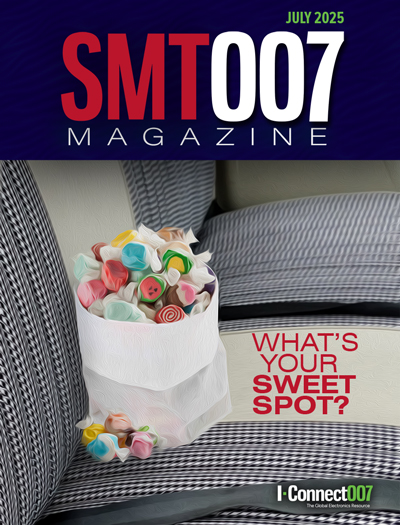-

- News
- Books
Featured Books
- smt007 Magazine
Latest Issues
Current Issue
Supply Chain Strategies
A successful brand is built on strong customer relationships—anchored by a well-orchestrated supply chain at its core. This month, we look at how managing your supply chain directly influences customer perception.

What's Your Sweet Spot?
Are you in a niche that’s growing or shrinking? Is it time to reassess and refocus? We spotlight companies thriving by redefining or reinforcing their niche. What are their insights?

Moving Forward With Confidence
In this issue, we focus on sales and quoting, workforce training, new IPC leadership in the U.S. and Canada, the effects of tariffs, CFX standards, and much more—all designed to provide perspective as you move through the cloud bank of today's shifting economic market.
- Articles
- Columns
- Links
- Media kit
||| MENU - smt007 Magazine
Solder Paste Jetting: An Integral Approach
November 21, 2018 | Jeff Leal, Gustaf Mårtensson, and Nerijus Augustis, Mycronic ABEstimated reading time: 11 minutes
Figure 15: Pad coverage for the 1206 component.
In Figure 16, volumetric deposit results are shown for the SO14, SO16, and SO20 component pads. All of these component pads show low volumetric deviation in delivered solder paste volume. The standard deviation of the delivered solder paste volume deviation for SO component pads was 5.2 nL, which is lower than 4% of the amount of pad coverage.
Figure 16: Pad coverage for components SO14, SO16, and SO20.
Reflow
The results of the solder joints after reflow in the vapor phase oven are good and were approved according to the specification of the customer. An X-ray inspection of the D-pack components showed issues with voids (Figure 17). The issue of voiding for this specific component was pre-existing and not judged to be dependent on the manner of paste deposition. Voiding was not an issue for the other utilized component types.
Figure 17: X-ray images after reflow on the D-pack and smaller components.
Process Factors
The waste level for the chosen ejectors and PCB layout measured to be approximately 15%. The values on weighted tubes and filter boxes before jetting and after jetting is represented in Table 1.
|
Ejector |
Tube weight before jetting (g) |
Tube weight after jetting (g) |
Filter box weight before jetting (g) |
Filter box weight after jetting (g) |
Waste level (%) |
|
1716P190 |
123.52 |
62.1 |
6.72 |
16.06 |
15.2 |
|
1716P201 |
115.92 |
19.64 |
6.72 |
22.12 |
16 |
Table 1: Waste values for both layouts and ejectors.
Conclusion
The jetting of solder paste due to the nature of the material requires a novel approach to transfer momentum without coining the material and enable actual high-volume production. To increase the throughput, the software and machine must run at the maximum possible rate given the arrangement of the dots on the board. Customer results demonstrate the capability of jetting different material volumes with a single hardware configuration accurately and repeatably. Further development has yielded advancements in smaller dot sizes for this ejector technology. Based on these results, it is clear that solder paste jetting can now be considered a viable option when compared to legacy solder paste deposition methods, while at the same time increasing the flexibility of a single production system.
Acknowledgments
We would like to acknowledge Anders Bo Pedersen at GP Elektronik A/S who was instrumental in helping with the SMT tests that are the basis for this paper.
Further Reading
- Franhoufer Chalmers. “Simulation of Jet Printing of Solder Paste.” Research Centre Industrial Mathematics. Accessed July 2017.
Editor's Note: This article was presented at the IPC APEX EXPO 2018 Technical Conference.
Testimonial
"We’re proud to call I-Connect007 a trusted partner. Their innovative approach and industry insight made our podcast collaboration a success by connecting us with the right audience and delivering real results."
Julia McCaffrey - NCAB GroupSuggested Items
Indium Promotes Huang to Senior Manager, Marketing Communications
08/28/2025 | Indium CorporationWith its commitment to innovation and growth through employee development, Indium Corporation announces the promotion of Jingya Huang to Senior Manager, Marketing Communications, to continue to lead the company’s branding and promotional efforts.
Rehm Academy Expands Its Training Program
08/28/2025 | Rehm Thermal SystemsThe demands on modern industrial companies and employees continue to rise, and therefore, the topic of further education is becoming increasingly important today.
MacDermid Alpha Awarded for Innovation: Driving Process Optimization and Efficiency with Major Indian EMS Provider
08/28/2025 | MacDermid Alpha Electronics SolutionsMacDermid Alpha Electronics Solutions, a leading global supplier of integrated materials for the electronics industry, is recognized by one of India’s top EMS providers, Syrma SGS, with an award for innovation that advanced process optimization, enhanced operational efficiency, and yield gains.
Integrated Solutions for Board-level Reliability: A Smarter Path Forward
08/27/2025 | Alan Gardner, MacDermid Alpha Electronics SolutionsIn today’s electronics manufacturing landscape, reliability is no longer just a benchmark but a business imperative. As industries such as automotive, aerospace, and high-performance computing (HPC) push the boundaries of innovation, the demand for dependable board-level performance under extreme conditions has never been greater.
ZESTRON Expands Capabilities with Addition of the EPS by i-Tech AG 75 Pallet Cleaning System
08/26/2025 | ZESTRONZESTRON, the global leader in high-precision cleaning solutions and services, is excited to announce the addition of a new capability in its Technical Center in Manassas, VA:


